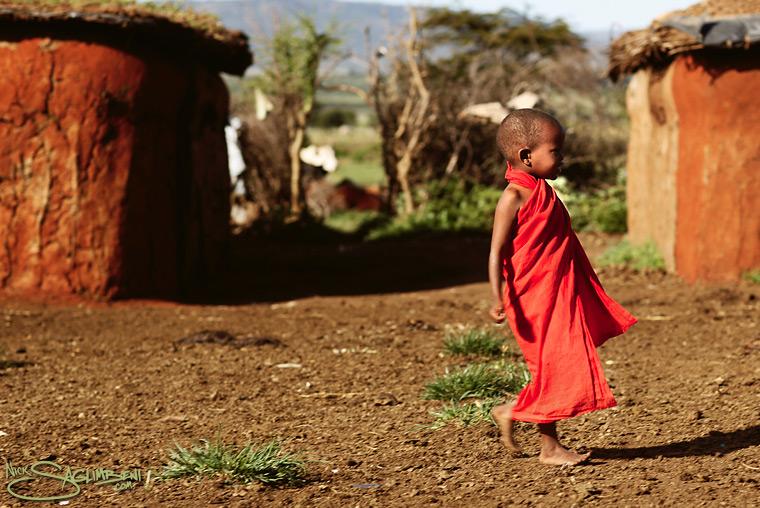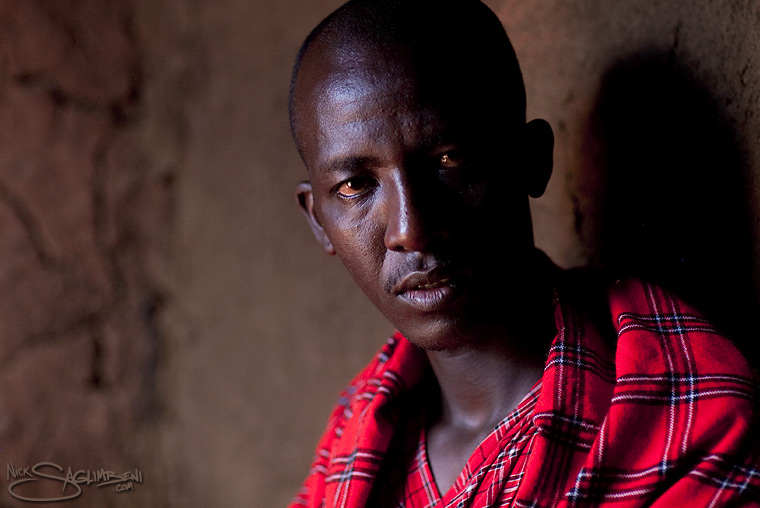Travelogue: KENYA — Living with the Maasai


I can see it so clearly. I’m 8 years old, and I’m in the Pleasant Plains elementary school library. I’m looking through my first National Geographic, and that’s when I see it—my first African tribe. I knew it right then: I had to get there—I was going to go live with them, learn their language, dress in their clothes, and do my darndest to become one of them. That was my dream, anyway.
So last month, while I’m on safari in Kenya at the Masai Mara wildlife preserve, I ask my driver if he can put me in touch with a local village chief (mzeé). He thought I was a bit nuts, but he came through with flying colors. He found me a guide who not only lives in a nearby Maasai tribal village (manyatta), but actually speaks a bit of English thanks to working nights as a safari camp security guard. I meet my guide, Meingati, the next morning, and he introduces me to the son of the chief, Kamwana (the chief was visiting friends in another village). Kamwana gives me a price to hang out in the village for an hour and take pictures. I tell him politely, no thank you—I want the real deal. So he agrees to let me stay in the village for two days, and it only costs me a cow.
My new friends welcomed me to Oltepesi village. They introduced me to members of their tribe, and showed me the usual tourist displays, like how to make fire, and a few tribal dances, including the ceremonial jumping, where men compete for brides by seeing who can jump the highest (seriously). I finally convinced them they didn’t need to entertain me—I just wanted to kick it with them however they, well, kick it. So we went off into the bush, tracked antelope by their poop, brushed our teeth with frayed sticks, and sat in the shade dodging the heat of the sun and napping. Then, we went to the Maasai market, which only happens once a week—I considered my timing extremely lucky. Hundreds, if not thousands, of Maasai walk from villages as far as Tanzania, to barter, haggle, and shop for everything from goats and cows to weapons (daggers, staffs, bows and arrows, AWESOME! I felt like I was playing D&D). I met many of their friends, some from distant lands, and ALL extremely friendly. I used this as my opportunity to learn some of the local Maasai language (Ma), which is completely different from the Swahili spoken throughout Kenya. Among my favorites were “Ero Sopa” (a familiar ‘hello’), “Ashi ashi” (thank you), and “Olesére ölcheré” (goodbye friend).
When we got back to the village, I played with the children for nearly two hours. I was surprised that a few of them even understood a little English. I realized then that the indigenous tribes are in every bit as much danger of cultural extinction, perhaps more, than the animals in the neighboring plains are of a physical one. That night, I drank cow milk from a giant gourd, listened to tribal songs, and slept on a floating cowskin stretched between four poles—one of the best nights of sleep in my life. The dwelling I stayed in was incredibly well-constructed, built by the women in the village, who do all the construction and build the entire village themselves. I lay there on my cow-bed, in awe of the wonder of the world, and enamored with my surroundings. The cool cross-breezes put me to sleep in no time.
The next morning, Kamwana came to my dwelling. He had a noticeable confidence apart from the others in the village, one that can only come with knowing you’re going to be the next chief (and having five wives). He gave me a Maasai bracelet, beautifully and thoughtfully sewn together bead-by-bead, and a shúkà, the traditional cloth cape worn by the men. He also gave me a Maasai name: Sarúni, meaning ‘the helpful one.’ I left just before nightfall on the second day, thanking my friends and wishing them well—and hoping it would not be the last time I would see them. I didn’t take as many pictures as I thought I would have. I felt a barrage of photos would have turned my experience into little more than a circus, and I wanted to keep it as genuine as possible. Sometimes you just need to turn off the camera and actually live.
My time with the Maasai was a defining moment in my life, because it symbolized the completion of a childhood dream. I only hope that these tribes will still be around for future generations to dream about. Olesére, ölcheré.
INDEX:
TOP IMAGES: (1) Maasai boy in Oltepesi village, (2) my guide, Meingati
ROW 1
1: (left to right) Meingati, Kamwana, Yenku, unknown
2: Village girl and traditional Maasai home
3: Maasai women performing a ceremonial dance
4: Kamwana making fire
5: Looking to Tanzania
6: Welcoming me into the village
7: Inside Kamwana’s home (30 second exposure…it was pitch black until your eyes adjusted)
ROW 2
1: Drinking cow milk from a hollow gourd
2: Yenku
3: The future chief, Kamwana (right)
4-7: Oltepesi village children

































[…] embarked on a whirlwind tour of the country. I visited my Maasai friends in Oltepesi village from my first trip to Kenya, and then we explored the wild, capturing breathtaking sites in stunning 3D. For the full gallery […]